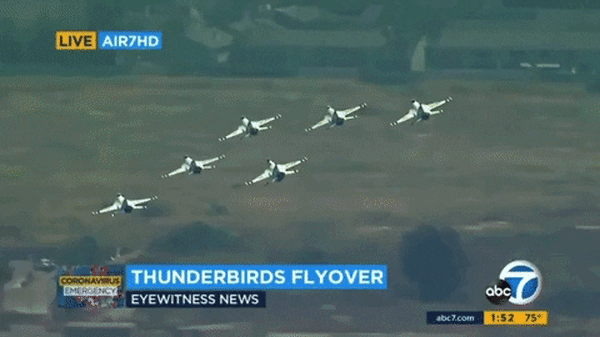

When you’re flying in tight formation at 400 miles an hour, you don’t have much time to react when things go wrong. But you also don’t get to be an an Air Force Thunderbirds pilot without quick reflexes, as was evident during the demonstration team’s flight over Los Angeles on Friday.
As you can see in footage from the flyover, Thunderbirds were soaring over the city in a tight delta formation when the #6 F-16 peeled off to the right in what looks like a move to avoid a potential collision with the #3 jet.
The War Zone, which first reported the incident, described it best:
“[Video] shows the formation heading south, towards Newport Beach. Then, at about 0:26, you can see Thunderbird #1 level out fairly quickly from what looks like a small correction turn, with #3 sliding-out towards #6 on the right end of the formation as a result. #6 catches the potential issue and takes a hard break to the right out of the formation so as to avoid a potential collision. The rest of the delta formation also loses its form a bit for a moment, but they suck back together as they go into a steeper left-hand turn.”

On Sunday, it was still unclear what caused the issue. However, the Thunderbirds wrote on its Instagram and Facebook pages that the team had to change its flight plan midway through the flight.
“The purpose of this flyover was to salute COVID-19 frontline responders in California. The published flight path was designed to flyover hospitals and densely populated areas to achieve this mission,” The Thunderbirds wrote. “However, the pilots made in-flight modifications to the pre-coordinated route due to an extremely high concentration of unexpected air traffic. These changes were made to ensure the safety and security of the pilots and public, which is always our top priority.”
Could the in-flight changes have led to the hiccup? Potentially, although the Thunderbirds did not immediately respond to request for comment from Task & Purpose.
No matter what caused the hiccup, the video shows that being a Thunderbird isn’t nearly as easy as the pilots make it look, and a slight twitch of the wings can have disastrous consequences if airmen aren’t ready to react to it.
According to The War Zone, “weather turbulence, other air traffic, birds and even the position of the sun” can affect the formation. With all this going on, it’s a testament to the pilots’ skill that things like this don’t happen more often.
The Los Angeles flyover was part of Operation America Strong, a series of nationwide flyovers that have seen the Thunderbirds and Navy Blue Angels soar above American’s major cities in a salute to health care workers and first responders during the novel coronavirus (COVID-19) pandemic.
